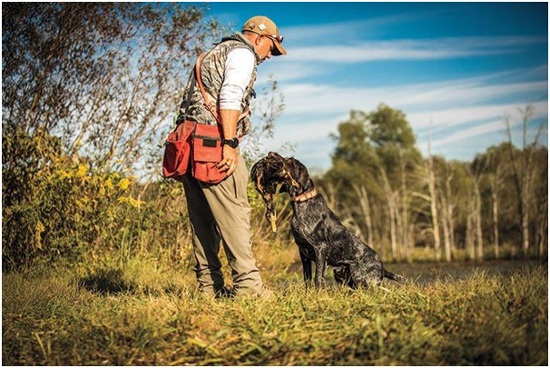Embarking on the journey of training a hunting dog is an exciting and rewarding endeavor. Whether you have a new puppy eager to learn the ropes or a seasoned dog in need of fine-tuning, understanding the right strategies and techniques for each stage of their development is crucial.
In this comprehensive guide, we’ll walk you through the process, from early socialization and obedience to advanced hunting skills.
So, grab your leash and get ready to explore the world of training your hunting dog at every stage. Your loyal companion’s full potential is waiting to be unlocked!
Choosing the Right Breed and Equipment for Your Hunting Dog
You must select the ideal breed and tools for your hunting style and objectives before you begin training your hunting dog. Different breeds have various personalities, talents, and limitations that could impact their performance and suitability for you.
For instance, while certain breeds are more adaptive and suitable for diverse hunting settings, others are more suited for retrieving, pointing, flushing, or tracking animals. The breed you choose should also be taken into account in terms of its size, coat, temperament, health, and upkeep.
Another important factor is the equipment you will use for your hunting dog. You will need a collar, leash, crate, bed, food, water, toys, treats, and grooming supplies for your dog’s basic needs. You will also need some specialised equipment for training and hunting purposes, such as a whistle, clicker, dummy, e-collar, vest, harness, GPS tracker, etc.
One of the most essential items is the best gun dog slip leads, which is a type of leash that can be quickly slipped on and off your dog’s neck without using a buckle or clip. This allows you to control your dog’s movements and prevent them from running off or chasing unwanted games.
Strategies and Techniques for Training Hunting Dogs for Every Stage
Training hunting dogs is a nuanced process that evolves with each stage of their development. From puppyhood to advanced hunting skills, a successful journey requires a tailored approach. Early on, socialization and basic obedience lay the foundation for a well-rounded hunting companion.
As the dog matures, specialized techniques like scent training and retrieval skills are honed to perfection. Finally, advanced strategies such as field trial simulations and real-world hunting scenarios refine their abilities.
Understanding these strategies and techniques for training hunting dogs at every stage ensures that your four-legged partner becomes a reliable and skilled asset in the field
Training Your Hunting Dog as a Puppy
Your hunting dog should be properly trained when they are still young. As compared to older dogs, puppies are more inquisitive, eager to learn, and susceptible to positive reinforcement. Nevertheless, you must be careful not to subject your puppy to excessive training or pressure. The training sessions should be brief, enjoyable, and rewarding for your puppy.
Some of the basic skills and commands that you should teach your hunting dog as a puppy are:
- Name recognition: When you call your puppy, you should reward them with praise or goodies if they look at you and answer to their name. This will aid in capturing their interest and forming a connection with them.
- Recall: By using a whistle or a vocal order, you should educate your puppy to return to you when you call. This will assist you in controlling and keeping your dog safe on the field.
- Sit: You should teach your puppy to sit on command by holding a treat above their head and saying “sit” as they lower their rear end to the ground. This will help you calm your dog down and prepare them for other commands.
- Stay: You should teach your puppy to stay in one place until you release them by using a hand signal or a verbal command. This will help you prevent your dog from running ahead or breaking their point.
- Heel: You should use a leash or a slip lead to train your puppy to walk alongside you without pulling or trailing behind. You can control your dog and communicate with it better in the field if you do this.
- Socialisation: You should take your puppy to numerous locations and scenarios so that they can be exposed to the many people, pets, sounds, smells, and settings that they may come across while hunting. They will develop more self-assurance, friendliness, and adaptability to new situations as a result.
Training Your Hunting Dog as an Adult
Once your hunting dog reaches adulthood (usually around 6 to 18 months old), you can start teaching them more advanced skills and behaviours that are specific to your hunting style and goals. These may include:
- Retrieving: You should teach your hunting dog to fetch and deliver game to you by using a dummy or a real bird. You should also teach them to hold the game gently in their mouth without damaging it.
- Pointing: You should teach your hunting dog to locate and indicate game by freezing in a stance with their head and tail pointing towards the direction of the game. You should also teach them to stay on point until you flush the game or release them.
- Flushing: You should teach your hunting dog to drive game out of cover by chasing or barking at them. You should also teach them to stop flushing when you shoot or command them.
- Tracking: You should teach your hunting dog to follow the scent trail of wounded or lost game by using blood or scent pads. You should also teach them to alert you when they find the game by barking or pointing.
Common Mistakes and Challenges in Hunting Dog Training and How to Avoid Them
Hunting dog training is not easy, and you may encounter some mistakes and challenges along the way. Some of the common ones are:
- Inconsistency: Inconsistency is when you do not follow through with your commands, rewards, or corrections, or when you change them frequently. This will confuse your dog and make them lose trust in you. To avoid inconsistency, you should be clear, firm, and consistent with your training methods, expectations, and goals.
- Impatience: Impatience is when you expect too much from your dog too soon, or when you lose your temper or get frustrated with your dog’s progress. This will discourage your dog and make them fearful or rebellious. To avoid impatience, you should be patient, calm, and positive with your training process, pace, and results.
- Overtraining: Overtraining is when you train your dog too much, too hard, or too often, without giving them enough rest, recovery, or fun. This will exhaust your dog physically and mentally, and make them lose interest or motivation in training.
To avoid overtraining, you should balance your training sessions with rest, recovery, and fun. You should also monitor your dog’s physical and mental condition and adjust your training accordingly. - Distraction: Distraction is when your dog gets sidetracked by something more interesting or exciting than the training task. This will reduce your dog’s focus and attention, and make them miss or ignore your commands.
To avoid distraction, you should train your dog in a quiet and controlled environment at first, and then gradually introduce more distractions as they improve. You should also reward your dog for paying attention and ignoring distractions. - Confusion: Confusion is when your dog does not understand what you want them to do, or when you give them conflicting or unclear signals. This will make your dog unsure and hesitant, and make them perform poorly or incorrectly.
To avoid confusion, you should use simple, consistent, and distinct commands, signals, and cues. You should also teach your dog one skill at a time, and review previous skills regularly.
Maintaining and Improving Your Hunting Dog’s Skills and Performance
The process of teaching your hunting dog must be ongoing and involve repetition and positive reinforcement. By giving your hunting dog the right diet, exercise, rest, and stimulation, you should always keep them in good physical and mental health.
You should also review and refresh their skills and commands before and after each hunting season or trip. You can also challenge and improve your hunting dog’s skills and performance by introducing new scenarios, distractions, or difficulties to their training sessions.
For example, you can use different types of game, terrain, weather, or cover to test your hunting dog’s abilities and adaptability.
Also Read: Top 10 Fastest Dog Breeds in the World
Conclusion
In conclusion, training your hunting dog is a dynamic and fulfilling journey that evolves alongside your four-legged friend’s growth. By applying the right strategies and techniques at each stage of their development, you can ensure they become a skilled and reliable hunting companion.
From the early days of socialization to advanced scent training and real-world hunting scenarios, your dedication and consistency will pay off in the field. Remember, the bond you build with your hunting dog is just as important as the skills you impart, so enjoy the process, and relish the adventures that await you both.
With the right training and a deep connection, you and your hunting dog can conquer the great outdoors together.
Happy hunting!




















